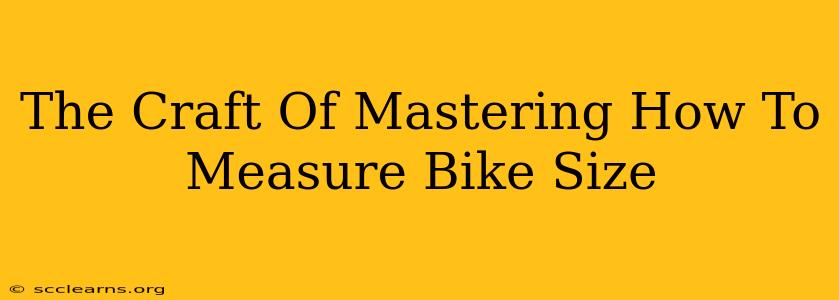Finding the perfect bike can feel like searching for a needle in a haystack. But the secret to unlocking comfort, performance, and injury prevention lies in understanding how to accurately measure your bike size. This isn't just about grabbing the nearest bike; it's about crafting a personalized cycling experience. This guide will delve into the essential methods and considerations for mastering bike size measurement, ensuring you ride confidently and comfortably.
Understanding Bike Sizing Systems: Beyond Just Inches
Bike sizing isn't a one-size-fits-all affair. Manufacturers use various systems, often incorporating measurements like:
- Frame Size: This traditionally refers to the length of the seat tube (the vertical tube connecting the bottom bracket to the seatpost). However, modern sizing often goes beyond this single dimension.
- Top Tube Length: The horizontal distance from the head tube to the seat tube. Crucial for determining reach and overall fit.
- Wheel Size: 26", 27.5", 29", and even gravel-specific sizes influence the bike's geometry and handling.
- Standover Height: The distance between the top tube and the crotch when standing over the bike. Important for ensuring clearance and preventing injury.
The Limitations of Generic Size Charts
While manufacturer size charts offer a starting point, they often lack the nuance to capture individual body variations. Relying solely on these charts can lead to an ill-fitting bike, impacting both comfort and performance. Therefore, taking precise body measurements is crucial.
Essential Body Measurements for Accurate Bike Sizing
To determine your ideal bike size, you'll need to take a few key body measurements:
- Inseam: Measure from your crotch to the floor while wearing shoes you'd typically cycle in. This is arguably the most crucial measurement.
- Arm Length: Measure from your shoulder to your wrist. This helps determine handlebar reach and stem length.
- Torso Length: Measure from your crotch to your shoulder. This is essential for finding the correct frame size for proper posture.
- Leg Length: Measure from your hip bone to your ankle. This helps determine optimal crank arm length and saddle height.
Pro-Tip: Use a measuring tape, stand against a wall, and enlist a friend for accurate measurements.
Beyond the Numbers: Geometry and Riding Style
While body measurements are key, you must also consider the bike's geometry and your riding style:
- Road Bikes: Tend to have a more aggressive geometry, prioritizing speed and efficiency.
- Mountain Bikes: Often have a more relaxed geometry, emphasizing stability and maneuverability.
- Gravel Bikes: Offer a balance between road and mountain bike geometries, suitable for varied terrains.
Understanding these nuances helps refine the bike size selection based on your specific needs and preferences. For example, a more aggressive rider might prefer a slightly smaller frame for a more responsive feel, while a more relaxed rider might prefer a larger frame for comfort and stability.
Test Riding: The Final Piece of the Puzzle
Once you've narrowed down potential bike sizes based on your measurements and riding style, the crucial next step is test riding. A short test ride allows you to assess the bike's fit and feel in a real-world setting. Pay attention to:
- Comfort: Can you comfortably reach the handlebars and pedals?
- Handling: Does the bike feel stable and responsive?
- Posture: Is your back straight, or are you overly hunched or stretched?
Don't hesitate to ask the bike shop staff for advice during the test ride. Their expertise can prove invaluable in fine-tuning your selection.
Professional Bike Fitting: Investing in Precision
For a truly personalized fit, consider a professional bike fit. A certified bike fitter will use advanced tools and techniques to analyze your body and riding style, optimizing your bike setup for maximum comfort, efficiency, and injury prevention. This is particularly beneficial for serious cyclists or those with specific physical limitations.
By diligently following these steps, you'll master the art of bike size measurement and confidently choose a bike that's perfectly tailored to you. Remember, a properly fitted bike significantly impacts your cycling enjoyment and overall experience. So, take the time, make the measurements, and enjoy the ride!

